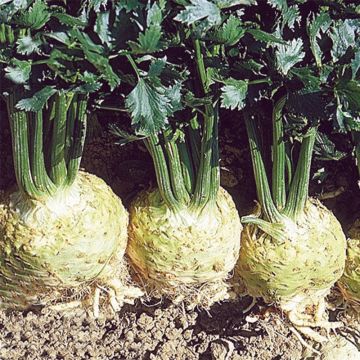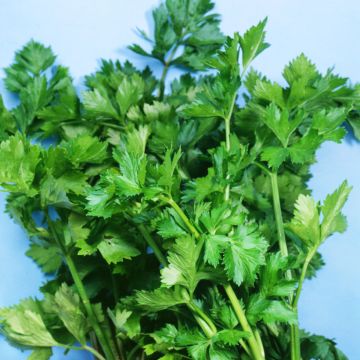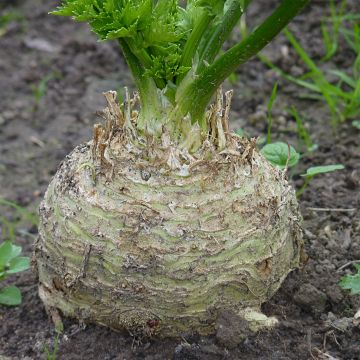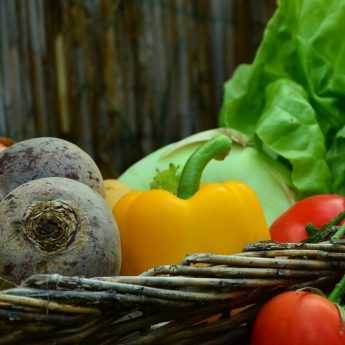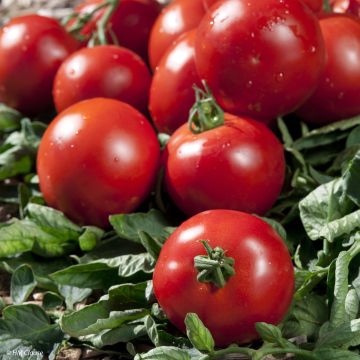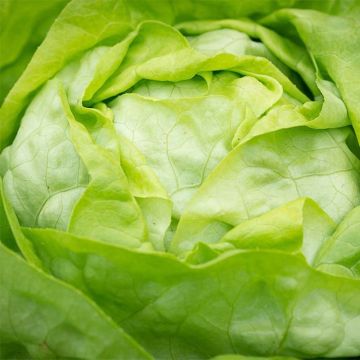

Golden Spartan Celery plugs - Apium graveolens
Golden Spartan Celery plugs - Apium graveolens
Apium graveolens Golden Spartan
Celery
This item cannot be shipped to the selected country
Delivery charge from €6.90
More information
Delivery charge from €6.90
More information
Schedule delivery date,
and select date in basket
This plant carries a 6 months recovery warranty
More information
We guarantee the quality of our plants for a full growing cycle, and will replace at our expense any plant that fails to recover under normal climatic and planting conditions.
From €7.90 for pickup delivery and €6.90 for home delivery
Express home delivery from €8.90.

Description
The Golden Spartan Celery is a variety with golden, finely cut and ample leaves. Its wide, fleshy and ribbed stalks are not stringy. Celery branch can be eaten raw, accompanied by an appetizer sauce, or cooked in soups and stews. The vegetable plugs of this variety can be planted from April to June, after the last frost, for a harvest in autumn.
Celery is a vegetable from the Apiaceae family (formerly Umbelliferae) and comes in various forms. The most common are celeriac, celery branch, and cutting celery. These three types of celery originate from the same plant, the marsh celery. The latter is a hardy perennial plant, native to Mediterranean countries, and is also known as perpetual celery.
In terms of cooking, celeriac is grown for its large round root, with a pungent flavour. It can be eaten raw (grated, in remoulade...) or cooked (mashed, gratin, or sautéed). Celery branch is grown for its stalks, which are the main veins of its leaves. These can be eaten raw, for example with salt, or cooked to flavour soups or sauces. The leaves of cutting celery are similar to parsley and perfectly enhance soups or simmered dishes. Celery is rich in vitamins, minerals, and low in calories.
In the vegetable garden, plant celery in a sunny or semi-shaded spot. It is a hardy plant that can reach 50 to 70 cm (20 to 28in) in height for celeriac and stalk celery. Only cutting celery is shorter and can be grown in a pot.
Celery appreciates moist, light, and rich soils. In the previous autumn, add well-rotted compost after loosening the soil. During cultivation, provide vegetable fertiliser as celery is demanding in terms of fertilisation. They are excellent autumn-winter vegetables, to be sown under shelter in spring.
Harvesting: For celery branch and cutting celery, pick the leaves at the base according to your needs, from 5 to 6 months after sowing. Before winter frosts, you can completely remove the plug and store it in a cellar for several weeks. As for celeriac, it is harvested in autumn and before the first frosts. Dig up the bulbs, let them dry for a day on the ground, and cut the leaves above the collar as well as the rootlets.
Storage: The leaves of celery branch and cutting celery are best consumed fresh to fully enjoy their aroma. However, they can be dried and used as an aromatic plant or frozen. Celeriac should be stored in a cool and humid place, protected from light, and can be kept for several months.
Gardener's tip: To reduce watering, we recommend that, from the end of May, you mulch the soil with thin successive layers of grass clippings, if possible mixed with dead leaves. This protection, which keeps the soil moist, also reduces weeding.
Harvest
Plant habit
Foliage
Other Celery
View all →Planting and care
Celery appreciates damp, light and rich soils. Add mature compost in the previous autumn after loosening the soil. Choose a sunny or semi-shaded location.
Planting:
Planting in open ground is done from mid-May to June, when the risk of frost has passed. Space the plants 35 cm (14in) apart in all directions. Soak the root ball in water for a few moments before planting. Dig a hole, place the plant and cover with fine soil. Water generously.
During cultivation, provide vegetable fertiliser as celery is nutrient-hungry. Regularly weed and hoe. Mulch at the base to maintain soil moisture. Water regularly, especially in hot weather. Avoid watering in the late afternoon to limit the risk of diseases.
Branch and cutting celery: Two weeks before harvest, the leaves need to be blanched. Blanch the stalks as you need them. By depriving them of light, the leaves will turn white as photosynthesis cannot take place. They will then be more tender. When the leaves are completely dry, gather them towards the center and tie them loosely with string. Make sure air can circulate. Surround them with thick cardboard, leaving just the top of the leaves exposed. Hill up the stalks. After 2 to 3 weeks, uncover the leaves and cut them just above the collar.
Celeriac: As the celeriac grows, when it is well formed, cut off the aerial rootlets.
Wait 4 years before growing celery in the same spot.
Cultivation
Care
Intended location
Planting & care advice
-
, onOrder confirmed
Reply from on Promesse de fleurs
Vegetable plants
Haven't found what you were looking for?
Hardiness is the lowest winter temperature a plant can endure without suffering serious damage or even dying. However, hardiness is affected by location (a sheltered area, such as a patio), protection (winter cover) and soil type (hardiness is improved by well-drained soil).

Photo Sharing Terms & Conditions
In order to encourage gardeners to interact and share their experiences, Promesse de fleurs offers various media enabling content to be uploaded onto its Site - in particular via the ‘Photo sharing’ module.
The User agrees to refrain from:
- Posting any content that is illegal, prejudicial, insulting, racist, inciteful to hatred, revisionist, contrary to public decency, that infringes on privacy or on the privacy rights of third parties, in particular the publicity rights of persons and goods, intellectual property rights, or the right to privacy.
- Submitting content on behalf of a third party;
- Impersonate the identity of a third party and/or publish any personal information about a third party;
In general, the User undertakes to refrain from any unethical behaviour.
All Content (in particular text, comments, files, images, photos, videos, creative works, etc.), which may be subject to property or intellectual property rights, image or other private rights, shall remain the property of the User, subject to the limited rights granted by the terms of the licence granted by Promesse de fleurs as stated below. Users are at liberty to publish or not to publish such Content on the Site, notably via the ‘Photo Sharing’ facility, and accept that this Content shall be made public and freely accessible, notably on the Internet.
Users further acknowledge, undertake to have ,and guarantee that they hold all necessary rights and permissions to publish such material on the Site, in particular with regard to the legislation in force pertaining to any privacy, property, intellectual property, image, or contractual rights, or rights of any other nature. By publishing such Content on the Site, Users acknowledge accepting full liability as publishers of the Content within the meaning of the law, and grant Promesse de fleurs, free of charge, an inclusive, worldwide licence for the said Content for the entire duration of its publication, including all reproduction, representation, up/downloading, displaying, performing, transmission, and storage rights.
Users also grant permission for their name to be linked to the Content and accept that this link may not always be made available.
By engaging in posting material, Users consent to their Content becoming automatically accessible on the Internet, in particular on other sites and/or blogs and/or web pages of the Promesse de fleurs site, including in particular social pages and the Promesse de fleurs catalogue.
Users may secure the removal of entrusted content free of charge by issuing a simple request via our contact form.



































